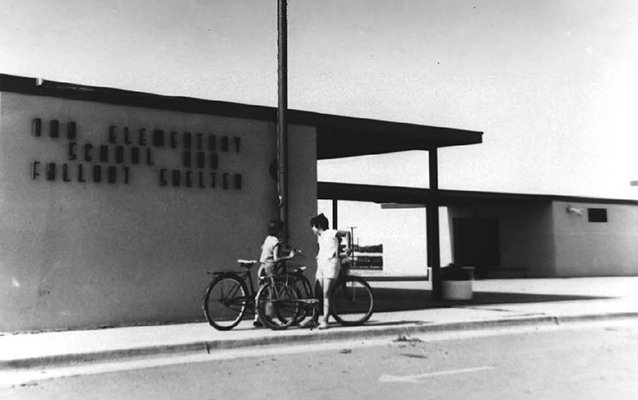Last updated: December 27, 2017
Place
Abo Elementary School and Fallout Shelter

Artesia Historical Museum & Art Center, Milt & Nancy Houston Collection
Located in the small southeastern New Mexico town of Artesia, the Abo Elementary School was built in 1962 to function as both a school and an underground fallout shelter for the community during the height of the Cold-War after plans by Roswell New Mexico architect, Frank M. Standhardt. With the exception of three, flat-roofed concrete block buildings (linked by a canopy to form a roughly shaped L in plan), the building is located completely underground and was engineered to withstand the effects of a thermonuclear blast. This was achieved by excavating below grade and constructing steel reinforced cast concrete walls and posts to support a 21-inch thick concrete slab roof. Heavy steel doors, designed to hold up under a nuclear explosion, were placed inside the three above ground entrances.
From 1962 until 1995, the building functioned as a public elementary school. It continued to enjoy a degree of notoriety through the 1960s and 1970s. Various educational experts visited the school during the 1960s, including the noted St. Louis researcher, Frank Lutz, who concluded that students at the subterranean school performed as well academically as their counterparts in above ground schools. The town was proud of the school and marketed it as a tourist attraction. Directional signs to the school were installed around Artesia and guided tours were offered by the school administrative office and the police department until the end of the 1960's.
Rectangular in plan, 18 of the school's 28 rooms originally functioned as class space while the remaining rooms were devoted to storage, rest rooms, and housing mechanical equipment for the building. The below-ground floor space of the school/fallout shelter is 33,835 square feet. Three sets of stairs (each located in one of the three above ground stuccoed concrete block entrance buildings) provide access to the school/fallout shelter. The two buildings at the south end of the complex provided access for students, while the most northerly building functioned as a teachers entrance and was built with a (still extant) decontamination shower for use in the event of a nuclear strike. A freight elevator located in an ell extending from the entrance building at southeast corner of the property was designed to bring food and supplies into the school/fallout shelter.
The school grounds encompass 10 acres in area and are set in a middle-class suburban neighborhood of Artesia. The concrete roof of the school/fallout shelter above-ground functions as a playground. Other than the three small buildings linked by a canopy, there is little to indicate the property contains a large public school facility and fallout shelter. Original steel lettering on the south facade of the concrete block building closest to Centre Avenue reads, Abo Elementary School and Fallout Shelter. A flagpole is fixed to this facade and rises above the roof of the building. The above ground buildings are devoid of windows or any ornamentation and are most distinguished by the metal canopies (supported by steel posts) that link them.
The rectangular plan of the subterranean building includes two symmetrically placed corridors (running lengthwise) off of which are located classrooms. Stairs from the surface are located at the north and south ends of the west corridor. A large area originally intended for use as a multi-use room is located at the south end of the building and is accessed by both main corridors. Food and bed storage areas as well as rooms for mechanical equipment and a morgue were located at the southeast corner of the building off of the multi-use room. Spaces intended for use as administrative offices, toilets and classrooms occupy the central part of the building. A room designated for use as tracking aids is located at the northeast corner of the school. Original acoustical tile covers the ceilings and pegboard and blackboards survive in all of the classrooms. In addition to traditional school features like classrooms and a cafeteria, Abo Elementary School featured an emergency entrance equipped with a shower to remove fallout particles, rations and supplies for 2,080 for two weeks, an air-conditioning system that could filter out radioactivity, a generator to supply emergency power, and a morgue. The extant 150-kilowatt generator, powered by a 319 horsepower diesel engine, drew its fuel from an underground storage tank that could hold 10,000 gallons. The building was also features an auxiliary water system, designed to supply the shelter's inhabitants with water during an emergency; the school used the Artesia's regular municipal water during normal operations, and the auxiliary system was used in the air conditioning system.
The Abo Elementary School and Fallout Shelter has had few alterations and, as a result, retains a high degree of historic integrity. All of the original mechanical systems in the building remain including the generator, air filtration system, and water and sewer systems. Two above ground portable classrooms were later moved onto the grounds, but have already been removed. The emergency rations, obsolete drugs and medicines, and body bags were discarded in 1989 at the end of the cold war, and the morgue was used as a storage space for cafeteria supplies. In the mid-1990s, the Artesia Public School system oversaw the construction of a new, aboveground elementary school just west of Abo Elementary, called Yeso School. The new school (located on the property just to the west of the original school) was designed to complement Abo Elementary, not to replace it. Abo Elementary School was closed in 1995.
